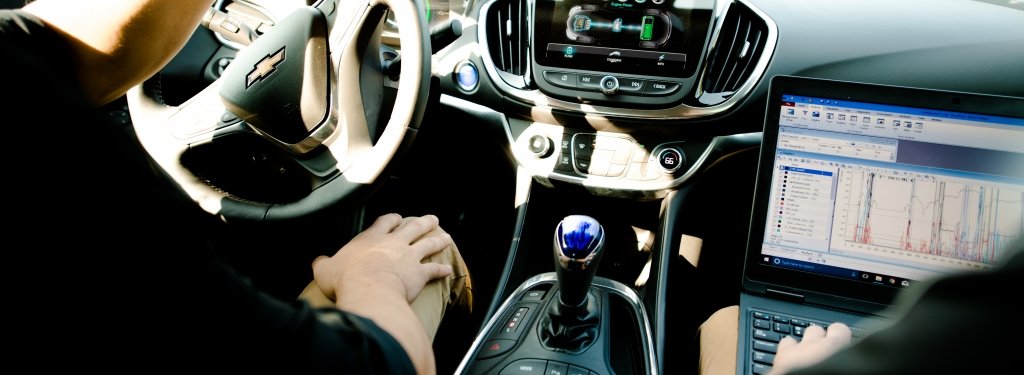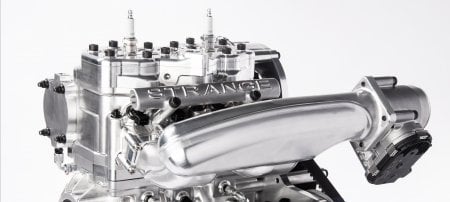There’s a method to my smart cities design.
To an engineer, Simulink is not that fancy. It’s like a big, plain Lego baseplate or a blank canvas. But the modeling software is a crucial tool in developing the technology and systems to support smart city infrastructure. Essentially, the design comes down to carefully engineered controls. And it starts in Simulink.
Graduate students Chong Cao and Joe Oncken work with researcher Bo Chen, the Dave House Professor of Mechanical Engineering and Electrical Engineering, in the Intelligent Mechatronics and Embedded Systems lab. They explain how they develop Simulink models for smart city technology — and show how the models shift into real-life testing.
“We develop and validate the controls in our process using a simulation first,” Cao explained, to which Oncken added: “Simulink is just an on-computer simulation software that’s all visual — you put building blocks together — and make an entire model of an electric car, the electrical grid.”
By sight, Simulink looks like a precise version of kid’s drawings in MS Paint, just little rectangles, ovals and lines. What’s cool about it — and kind of like a grown-up version of MS Paint’s stamps — is that each shape and connection carries data and directives that flow through the model. Instead of writing endless lines of code, engineers can drag and drop preprogrammed objects into Simulink and study highly complex systems.
Powertrain
Oncken is a hands-on engineer, but not all of his work is done under the hood of one of the hybrid-electric vehicles in a fleet maintained by the Advanced Power Systems Labs (APS LABS). In an effort to maximize fuel efficiency in the fleet’s Chevy Volts, he works where the car’s digital and mechanical parts meet.

“I work on powertrain control,” Oncken said. “I look at future driving conditions, such as changing traffic lights, and modify the vehicle’s powertrain operation to use the minimum amount of fuel.”
So, in his Simulink model, Oncken looks at predictive controller design. That means when a traffic signal turns red, a self-driving vehicle not only knows to stop, but also gets directions on the best way to slow down and minimize fuel use. Oncken simulates this in the model, embeds the program into the Chevy Volt, then tests it using five upgraded traffic signals in Houghton that rely on dedicated short-range communication (DSRC) to talk directly to the car’s programming.
In a 40-minute loop from the APS LABS by the airport through Houghton, around campus and back to the lab, Oncken’s program can save 5% of fuel. Those savings can quickly add up. Plus, the connectivity doesn’t end there: Cao’s work picks up where Oncken’s plugs in for the night.
Power Grid
In his Simulink model, Cao looks at how to maximize building design for real-time metering and coordinate the electric vehicle charging process. When an electric vehicle gets plugged into the grid to charge, it draws power. But when it’s fully charged and still plugged in, it can serve as a battery bank. It's not as simple as plugging in a phone to charge, though, and figuring out how to balance the vehicle's draw in relation to other electrical uses is important. Power providers and building managers need to keep tabs on those varying states and adjust accordingly.

The key technology, and the one that Simulink helps Cao test, is built on a platform that connects machine-to-machine communication in the Internet of Things (IoT). It’s called message queuing telemetry transport (MQTT). In a nutshell, the IoT connects cars, phones, smart fridges, smart meters, smart watches and other physical devices with digital interfaces, which all need a way to communicate. People use handwritten sticky notes, the Post Office, What’sApp and Facebook Messenger to talk; machines use MQTT.
“We’re trying to bridge the gap,” Cao said. “We need to communicate with all the components and get all the information to interface with the building management system.”
In Cao’s work, each node within Simulink builds up into a microgrid. In Oncken’s work, each mode provides input to the vehicle’s powertrain. Whether a node or a mode, a car or a building, the blank canvas of Simulink lets engineers quickly piece together models of the technologies that are swiftly changing our roads, homes, schools and businesses.
Michigan Technological University is an R1 public research university founded in 1885 in Houghton, and is home to nearly 7,500 students from more than 60 countries around the world. Consistently ranked among the best universities in the country for return on investment, Michigan's flagship technological university offers more than 185 undergraduate and graduate degree programs in science and technology, engineering, computing, forestry, business, health professions, humanities, mathematics, social sciences, and the arts. The rural campus is situated just miles from Lake Superior in Michigan's Upper Peninsula, offering year-round opportunities for outdoor adventure.






Comments